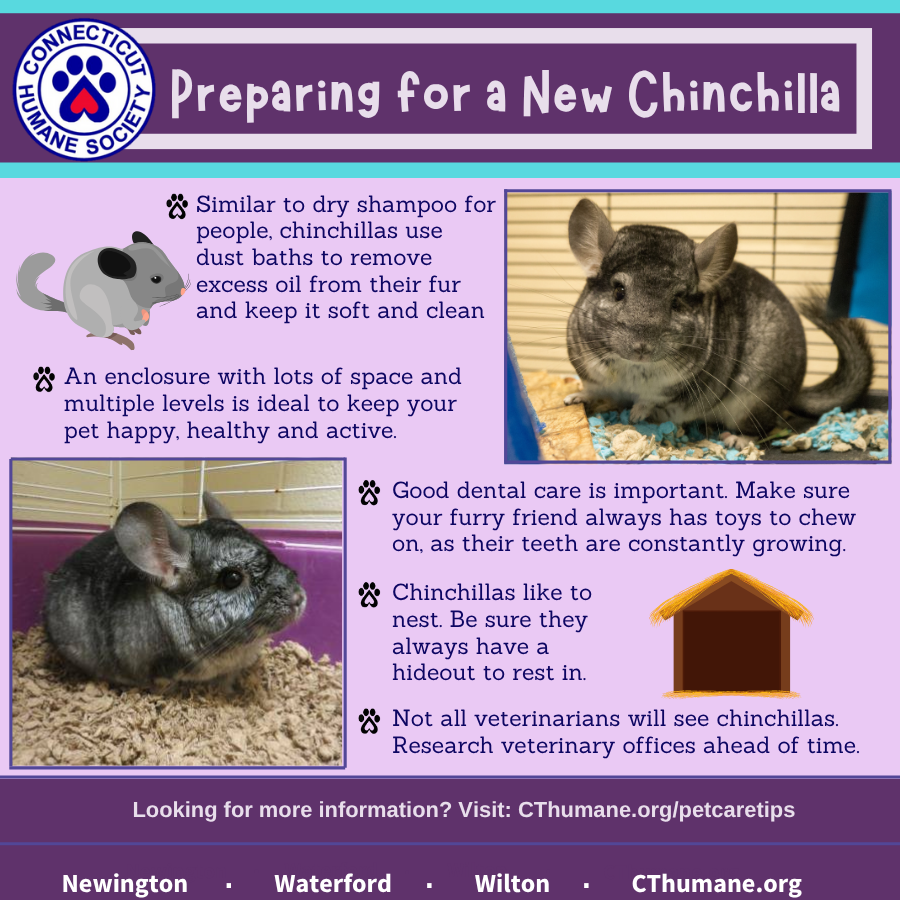
“What pet should I get?” It’s not just the title of a Dr. Suess book, it’s a question often heard from a first-time visitor to the Connecticut Humane Society. You’ve already thought about the pros and cons and whether or not you’re ready to get a pet, but you still might be on the fence about what type of pet you want. Or maybe you just adopted a pet, and you want to make sure you’ve covered all your bases. Check out these tips to start.
Chinchillas are gorgeous, have adorable eyes, and are oh-so-very soft. These little guys are up late at night and early in the morning – which can be a good thing as they sleep the day away while you’re at work or school. They’re a long-term commitment, though. With proper care, chinchillas can live 10 or more years. Are they the right pet for you?
Basic Information
- Average adult size: 12 inches long
- Average life span: 10+ years with proper care
- Chinchillas can be kept in same sex pairs/groups or individually. If unaltered males and females are kept together, breeding or fighting may occur.
- Chinchillas are nocturnal; they are active at night and sleep during the day.
- Always wash your hands after handling your pets or cleaning their dishes, cage, toys, etc.
Diet and Feeding
- Fresh food and water should always be available. Most chinchillas are accustomed to drinking from a water bottle.
- Timothy hay should make up the majority of their diet, along with specialized chinchilla pellets and a small amount of leafy green vegetables daily. Fruits may also be given once a week as a treat.
- Vegetables and fruits not eaten within a few hours should be discarded.
- Clean, fresh, filtered, chlorine-free water, changed daily.
- Do not feed chocolate, caffeine or alcohol as these can cause serious medical conditions. Avoid sugar and high fat treats.
Housing
- Chinchillas acclimate well to average household temperatures, not above 80°F. Avoid extreme temperature changes. The habitat should be placed in an area that is away from drafts and direct sunlight.
- The habitat should be large with multiple levels to allow jumping and a solid floor. The space between the bars of the cage should not exceed 1”. It is best to provide the largest habitat possible.
- 1-2” of paper bedding, such as Carefresh, is recommended. Cedar shavings should not be used as bedding.
- Clean and disinfect the habitat and non-porous toys regularly; remove wet spots daily. Bedding should be changed at least once a week or more often if necessary.
Enrichment
- Provide a variety of chewable toys to promote proper teeth wear as a chinchilla’s teeth grow continuously.
- Your chinchilla will appreciate out-of-cage time. Just make sure to always supervise the little guy as you don’t want them chewing on your walls, furniture or electronics.
Grooming
- Chinchillas require a dust bath twice a week. The dust bath should be removed from the habitat after 15-30 minutes.
- Do not get your chinchilla wet as their coat absorbs water which can lead to bacterial growth, chills, and illness.
Health and Veterinary Care
A healthy chinchilla should be active, alert, and sociable, eating and drinking often, with healthy fur and clear eyes. A chinchilla who is inactive, losing weight, has eye or nasal discharge, diarrhea, hair loss or distressed breathing may be sick. If you notice these any of these signs, see your veterinarian right away.
